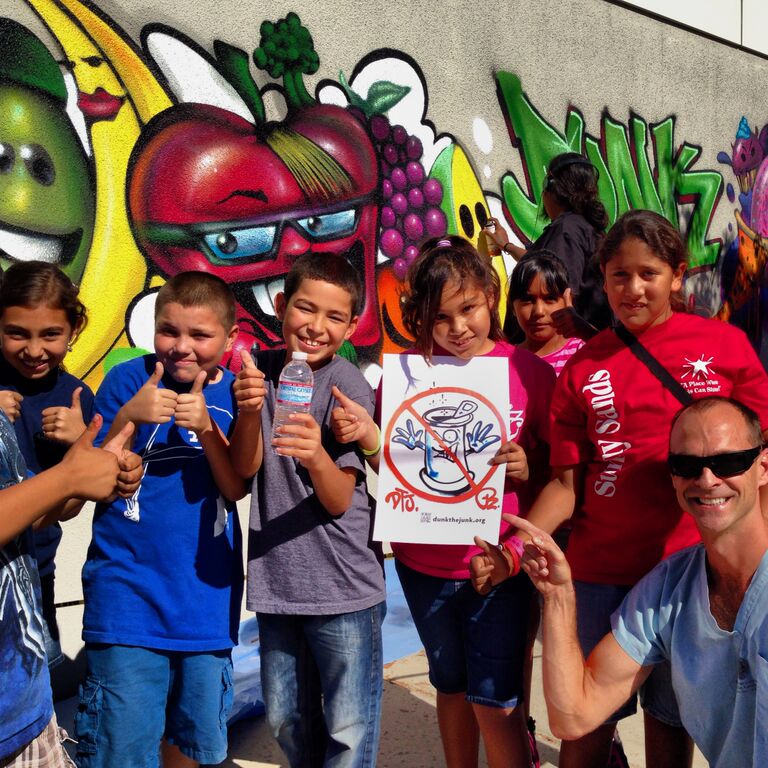
Share On Social!
Can a rap song or graffiti art help kids eat healthier?
Dr. Kevin Strong wanted to give it a shot and compete with the unhealthy marketing that kids—especially Latinos—are bombarded with daily.
So founded the “Dunk the Junk” movement to work in schools and through social media to tailor health messages to kids in a fun way to counter junk food advertising. He uses rap, hip-hop dance, basketball, and graffiti art to change what kids think is cool to eat.
“I love basketball and I would see a million junk food ads every time I watched,” Strong told Style101 Magazine. “I was just really saddened by the all children that are coming in [to my clinic] real young, devastated by junk food exposure.”
The Need for Counter Marketing
In his many years as a community pediatrician in Maine, Dr. Kevin Strong saw countless kids with poor nutrition habits.
While interning for University of California, San Diego (UCSD), Strong saw that Latino immigrant families who start eating the “American Diet”—processed food and sugary drinks—end up showing signs of obesity.
“You could see a really sharp difference between a recent Mexican immigrant family, who came from villages in Mexico, who was not having junk food all day, and the ones who have been here for more than two years. They transform from a diet of rice and beans to a diet of hot chips and Pepsi,” Strong said.
Why?
Strong realized food marketers were fueling kids—especially Latinos, African Americans, and Native Americans—with the wrong messages about food and drinks, contributing to their poor diets and sugary beverage addictions.
Existing food advertising specifically influences children ages 2-11 to prefer and request high-calorie, high-sugar, low-nutrient foods and drinks, according to report by the Institute of Medicine. Many studies link obesity to consumption of sugary drinks and high-sugar foods.
Strong realized that junk food and sugary drink companies target kids, especially kids of color.
He learned that Latino kids see more junk food ads on TV than their non-white peers, affecting their addictions to these foods and sugary drinks. Marketers are more attracted to Latino kids because of their increasing population size, media exposure, and buying power, studies show.
Latinos also are disproportionally affected by nonalcoholic fatty liver disease, the leading cause of liver disease in children. One in 100 U.S. kids will require liver transplantation from overconsumption of sugar, Strong said.
“The odds are stacked against the families and the children. The schools serve sugary foods. The TV is inundated with ads,” Strong said. “Basically before they [the kids] even know or have a chance to make a decision, they are just addicted to sugary foods. It distorts your taste buds. So if you are eating chips and sodas all day, broccoli does taste horrible.”

As a pediatrician, Strong has always urged parents to prevent sugar and salt addictions among their children.
“This is your chance,” he tells them. “If your child never experiences the unnatural flavor intensities of process junk foods then you won’t have a picky eater.”
But he wanted to do more.
Strong decided to step outside the clinic and combat unhealthy marketing.
He started developing an educational program, called “Dunk the Junk,” that would work with schools to bring tailored health messages to students in fun ways, such as hip-hop songs and graffiti art.
Strong, a collegiate swimmer at Duke University isn’t a graffiti artist or rapper. He just wanted to find a way to engage kids on their own terms.
“My plan was to inspire a counter-culture movement in the basketball, hip-hop and graffiti worlds, to dismantle the junk food epidemic with style,” Strong told Style101 Magazine.
Building a New Kind of Healthy Ad
Strong tracked down local street artist Too Rich (Mike Rich) and enlisted him.
They and a core group of artists started to develop ideas for Dunk the Junk street art and images, songs, videos, web pages and more to target unhealthy foods and drinks and promote healthier options.
They approached schools, and vice versa, to apply the program.
They started testing the program in Maine, and moved into Philadelphia.
“We attract kids with our street art, ethos savvy beats and acrobatic slam-dunks; and then educate them about the perils of excessive sugar intake,” Strong told Style101 Magazine.

When Strong visits a potential school for Dunk the Junk, he considers the children’s demographics, what they like, and how to fine-tune messages.
What are they ready to do? Are they afraid of diabetes? Are they angry about social injustice? What are they into?
Strong always decides to keep the message focused on the kids and incorporate their art and language into every school he visits. Strong uses kids’ lingo, art, and rap and then combines it with his team’s artists to help design the murals, songs and memories that kids will not soon forget.
“I just wanted to come up with a cool way to turn around all the predatory branding and marketing,” Strong said.
Schools have to pay to bring Dunk the Junk staff and artists, but costs usually are supported by private donations or grants. Strong’s team also helps schools secure funding.
Taking ‘Dunk the Junk’ National
Janie Bark heard about Dunk The Junk on NPR.
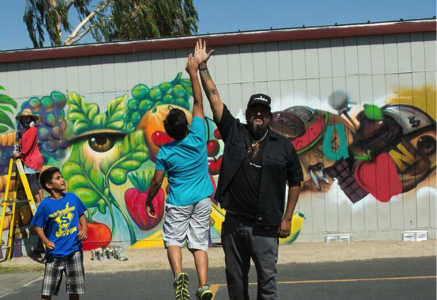
Bark, the director of a Palm Springs, Calif., YMCA after school program, called A.S.E.S (After School Education and Safety Program), thought Strong would be a good fit for her program, which enlists people to talk about health and physical activity and reduce gang participation.
“I was sitting in the car one time listening to NPR and I heard them say something to the effect of, ‘Now next is the pediatrician from Camden, Maine, who is talking about childhood obesity,’ and I thought, ‘Wow!’” she said.
Bark decided to email Strong to see if his team could come to California, and she got a quick call back from him.
“I could just sense his passion over the phone, and I just knew we had to get a partnership going and find it in our budget to have him come out, the sooner the better,” she said.
As with any partner school, Strong had to think about how to connect with the kids—in this case an area with a large Latino population—and bring a new rap on health and graffiti art in Palm Springs.
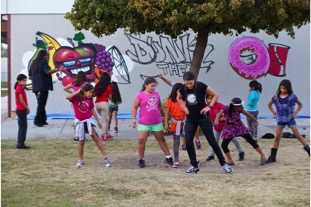
Students in Bark’s A.S.E.S. program struggle with healthy food choices, as 99% are in the free and reduced lunch demographic, she said.
Strong envisioned reversing childhood obesity in this area through incorporating hip-hop dance, graffiti art and a presentation on how to literally “Dunk the Junk” by throwing away junk food in the trash.
In October 2011, the Palm Springs School District’s A.S.E.S program obtained a grant from the Family of YMCA of the Desert.
Dunk the Junk’s team packed their bags and started implementing Dunk the Junk in Palm Springs that fall.
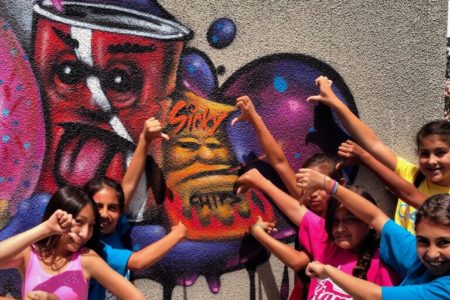
Strong worked with a local Latino graffiti artist Vyal from Los Angeles and a hip-hop dancer from Strong’s original team in Maine, Kea Tesseyman to implement Dunk the Junk in California.
Strong does an informational presentation. Tesseyman ties in a couple hip-hop dance moves, getting the kids hearts pumping, and Vyal incorporates the kid’s art into one large painted mural. One part of the mural showed a thermometer coming out of a Takis hot chips bag to make it look sick—Takis and Hot Cheetos are very popular among Latino kids, but Strong pointed to articles that they can be addictive and cause so much stomach acidity that kids can be sent to the ER for eating too many.
Program Growth
Strong has visited more than 20 schools in Palm Springs over the last four years.
“We specifically talk about targeted marketing when we go into minority communities. This year I showed them [the students] the quote from the Coca-Cola…quote about how they plan to progressively target Latinos and African American and developing nations,” he said. “I put that into the talk and say, ‘These companies know that these foods are bad for you. They will give you diabetes, tooth decay, weight gain, heart disease, and here’s what their plan is: to target directly at you.’”
Strong has also brought Dunk the Junk to Brooklyn, Miami, Maine, Atlanta, and Richmond, Calif.
In other Dunk the Junk cities, a local basketball star or famous rapper participate.
In Atlanta, for example, ex-NBA player Dominique Wilkins came into a gym and surprised the kids with a slam dunk, and kids got to “dunk” too, by throwing bags of chips and draining sugary drinks into hoop-like trashcans.

Strong usually tries to visit schools where they can make the biggest impact.
“We give preference to schools that have higher percentage of free and reduced meals,” he said.
Kids react to Dunk the Junk by changing the way they think about soda and what they eat in school, and sharing these changes with friends and in social media, Strong said.
In Palm Springs, Bark said the program makes lasting impressions on school lunch and snack options, as kids will refuse chocolate milk and want healthier snack options.
She recalls hearing kids say, “Hey we don’t want that, Dr. Strong said it’s not good for us.” A teacher even called Bark to tell her a story about how her classroom didn’t want sodas and chips at their end of year party and instead wanted to bring bottled water and cups up fruit.
“He inspired not only our children, but our families, our own staff,” Bark said.
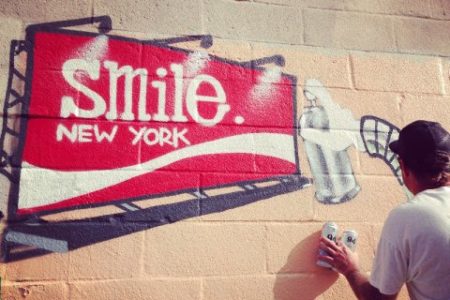
Strong, who still works full-time as a pediatrician along with his national Dunk the Junk program, is developing “pods” to keep the movement going in new schools.
“We have a couple pods developing. For instance there’s a physician in Sacramento area, who happens to be a street artist and loves the campaign,” he said. “So, I sent him my standard talk and drop boxed my slides to him and connected him to similar artists in the area.”
Also, Strong is developing a pod in New York City from a NYC Health Department grant, which contracted the team to do some messaging in Harlem and Brooklyn.
“Were going to go with our original team, then we will train up other [Dunk the Junk teams],” he said.
The team works on organizing and writing grants to help fund their projects in schools.
However, if the schools can’t find full funding, they are willing to work with them.
“If they come up with the funding through the PTA or grants that they have, we try to meet them at whatever budget they have,” he said.
Dunk the Junk also funds some of its school projects by offering T-shirts, stickers, wristbands and a new CD.
Overall, Strong hopes that kids will understand what they are consuming, and why it’s important to eat and drink healthy foods. He spreads his message on social media as well to really impact all young generations.
“I want to keep getting the message to as many children as possible, because I think when kids really know the truth about what this food does to them, and what these companies’ ethics are, I think that’s going to really turn the file,” Strong said.
By The Numbers
142
Percent
Expected rise in Latino cancer cases in coming years
This success story was produced by Salud America! with support from the Robert Wood Johnson Foundation.
The stories are intended for educational and informative purposes. References to specific policymakers, individuals, schools, policies, or companies have been included solely to advance these purposes and do not constitute an endorsement, sponsorship, or recommendation. Stories are based on and told by real community members and are the opinions and views of the individuals whose stories are told. Organization and activities described were not supported by Salud America! or the Robert Wood Johnson Foundation and do not necessarily represent the views of Salud America! or the Robert Wood Johnson Foundation.



